The Vibration Response Characteristics of Neighboring Tunnels Induced by Shield Construction
Abstract
:1. Introduction
2. Basic Theory
2.1. Vibration Energy Density Decay Theory
2.2. Microscopic Concrete Particle Vibration Energy State
3. Monitoring Data Validation Analysis
3.1. Project Overview
3.2. Monitoring Program
3.3. Monitoring Results
3.3.1. Analysis of Vibration Monitoring Results on the Construction Tunnel Side
3.3.2. Vibration Response of Neighboring Tunnel
4. Numerical Model Validation
4.1. Boundary Condition Setting
4.2. Calibration of Model Parameters
4.3. Analysis of Simulation Results
5. Discussion
5.1. Distribution and Attenuation Patterns of Vibration Energy
5.2. Axial and Radial Vibration Characteristics
5.3. Validation of Theoretical Models Through Numerical Simulation
5.4. Significance of Vibration Control and Mitigation
6. Conclusions
- (1)
- Vibration energy distribution and attenuation law: Vibration energy is mainly concentrated in the low-frequency band of 3–4 Hz, and there is an exponential attenuation trend in the propagation process. This shows that the vibration impact of shield construction on the surrounding structure has obvious spatial limitations, and the vibration energy is rapidly decaying in the area closer to the vibration source.
- (2)
- Tunnel axial and radial vibration characteristics: The axial vibration response on the construction tunnel side is the strongest, which gradually decays with increasing distance, while the radial vibration response on the neighboring tunnel side is more significant. This difference is due to the different characteristics of the vibration propagation path and the soil medium.
- (3)
- Verification of theoretical model and numerical simulation: Numerical simulation based on PFC3D verifies the correctness of the theoretical formulas, and further reveals the important role of the damping effect of the soil medium and segment structure in the vibration propagation process. The fitting results show that the variation in the damping ratio is in line with the actual situation, which provides a reliable basis for vibration energy prediction.
Author Contributions
Funding
Institutional Review Board Statement
Informed Consent Statement
Data Availability Statement
Acknowledgments
Conflicts of Interest
References
- Zhou, C.; Feng, Q.; He, W. Research review on environmental vibrations in metro depot and over-track buildings induced by train operation. Traffic Transp. Eng. 2023, 23, 27–46. (In Chinese) [Google Scholar]
- Feng, Q.; Lei, X.; Lian, S. Review of researches on environmental vibration induced by high-speed trains. East. China Jiaotong Univ. 2008, 25, 1–5. (In Chinese) [Google Scholar]
- Ma, L.; Liu, W. Sliced finite element-infinite element coupling model for predicting environmental vibration induced by metro train. Chin. Rock Mechan. Eng. 2016, 35, 2131–2141. (In Chinese) [Google Scholar]
- Jin, Q.; Thompson, D.; Lurcock, D.; Ntotsios, E. The shadow effect on the ground surface due to vibration transmission from a railway tunnel. Transp. Geotech. 2020, 23, 100335. [Google Scholar] [CrossRef]
- Wu, K.; Zheng, Y.; Li, S.; Sun, J.; Han, Y.; Hao, D. Vibration response law of existing buildings affected by subway tunnel boring machine excavation. Tunn. Undergr. Space Technol. 2022, 120, 104318. [Google Scholar] [CrossRef]
- Wang, X.; Han, X.; Zhou, H. Numerical Simulation on Vibration Response of Surrounding Ancient Buildings Induced by Shield Tunneling: Case Study on Line 8 of Beijin el Construction. Tunn. Constr. 2013, 33, 822–827. (In Chinese) [Google Scholar]
- Wu, J.; Liu, Q.; Zhang, X.; Zhou, C.; Yin, X.; Xie, W.; Liang, X.; Huang, J. Attenuation characteristics of impact-induced seismic wave in deep tunnels: An in situ investigation based on pendulum impact test. J. Rock Mech. Geotech. Eng. 2022, 14, 494–504. [Google Scholar] [CrossRef]
- Landar, S.; Velychkovych, A.; Ropyak, L.; Andrusyak, A. A Method for Applying the Use of a Smart 4 Controller for the Assessment of Drill String Bottom-Part Vibrations and Shock Loads. Vibration 2024, 7, 802–828. [Google Scholar] [CrossRef]
- Belov, V.; Rybak, S.; Tartakovski, B. Propagation of vibrational energy in absorbing structures. Sov. Phys. Acoust.-USSR 1977, 23, 115–119. [Google Scholar]
- Nefske, D.J.; Sung, S.H. Power Flow Finite Element Analysis of Dynamic Systems: Basic Theory and Application to Beams. J. Vib. Acoust. 1989, 111, 94–100. [Google Scholar] [CrossRef]
- Wohlever, J.; Bernhard, R. Mechanical energy flow models of rods and beams. J. Sound Vib. 1992, 153, 1–19. [Google Scholar] [CrossRef]
- Wohlever, J.; Bernhard, R. Energy distributions in rods and beams. In Proceedings of the AIAA 12th Aeroacoustics Conference, San Antonio, TX, USA, 10–12 April 1989. [Google Scholar] [CrossRef]
- Bouthier, O.; Bernhard, R. Simple models of energy flow in vibrating membranes. J. Sound Vib. 1995, 182, 129–147. [Google Scholar] [CrossRef]
- Bouthier, O.; Bernhard, R. Simple models of the energetics of transversely vibrating plates. J. Sound Vib. 1995, 182, 149–164. [Google Scholar] [CrossRef]
- Bernhard, R.J.; Huff, J.E., Jr. Structural-acoustic design at high frequency using the energy finite element method. Int. Des. Eng. Tech. Conf. Comput. Inf. Eng. Conf. 1995, 97652, 565–576. [Google Scholar]
- Wang, X.; Han, X.; Zhou, H.; Lei, C. A method to predict vibration responses induced by metro shield tunneling. China Civ. Eng. J. 2015, 48, 222–227. (In Chinese) [Google Scholar]
- Gupta, S.; Stanus, Y.; Lombaert, G.; Degrande, G. Influence of tunnel and soil parameters on vibrations from underground railways. J. Sound Vib. 2009, 327, 70–91. [Google Scholar] [CrossRef]
- Suwansawat, S.; Einstein, H.H. Describing settlement troughs over twin tunnels using a superposition technique. J. Geotech. Geoenvironmental Eng. 2007, 133, 445–468. [Google Scholar] [CrossRef]
- Ivan, S.; Andrii, V. Analytical Model of Structural Damping in Friction Module of Shell Shock Absorber Connected to Spring. Shock. Vib. 2023, 2023, 4140583. [Google Scholar]
- Chehade, F.H.; Shahrour, I. Numerical analysis of the interaction between twin-tunnels: Influence of the relative position and construction procedure. Tunn. Undergr. Space Technol. 2008, 23, 210–214. [Google Scholar] [CrossRef]
- Funatsu, T.; Hoshino, T.; Sawae, H.; Shimizu, N. Numerical analysis to better understand the mechanism of the effects of ground supports and reinforcements on the stability of tunnels using the distinct element method. Tunn. Undergr. Space Technol. 2008, 23, 561–573. [Google Scholar] [CrossRef]
- Papadopoulos, M.; François, S.; Degrande, G.; Lombaert, G. The influence of uncertain local subsoil conditions on the response of buildings to ground vibration. J. Sound Vib. 2018, 418, 200–220. [Google Scholar] [CrossRef]
- Comodromos, E.M.; Papadopoulou, M.C.; Konstantinidis, G.K. Numerical assessment of subsidence and adjacent building movements induced by TBM-EPB tunneling. J. Geotech. Geoenvironmental Eng. 2014, 140, 04014061. [Google Scholar] [CrossRef]
- Ding, D. Prediction of vibrations from underground trains on Beijing metro line 15. J. Cent. South Univ. Technol. 2010, 17, 1109–1118. (In Chinese) [Google Scholar] [CrossRef]
- Oliaei, M.; Manafi, E. Static analysis of interaction between twin-tunnels using discrete element method (DEM). Sci. Iran. 2015, 22, 1964–1971. [Google Scholar]
- Kuo, K.; Verbraken, H.; Degrande, G.; Lombaert, G. Hybrid predictions of railway induced ground vibration using a combination of experimental measurements and numerical modelling. J. Sound Vib. 2016, 373, 263–284. [Google Scholar] [CrossRef]
- Gu, G.; Zhang, Z.; Huang, X.; Li, Y.; Lei, Q. A finite element-based dynamic simulation method for modeling shield-ground interactions: 3D numerical simulations with comparison to physical experiments. Comput. Geotech. 2024, 169, 106262. [Google Scholar] [CrossRef]
- Mücahit, N.; Fuat, A. Investigation of effects of dynamic loads in metro tunnels during construction and operation on existing buildings. Arab. J. Geosci. 2020, 13, 424. [Google Scholar]
- Zhang, X.; Qu, H.; Xu, Y.; Zhang, L.; Zhang, Z. Investigating the damage to masonry buildings during shield tunneling: A case study in Hohhot Metro. Eng. Fail. Anal. 2024, 160, 108147. [Google Scholar] [CrossRef]
- Yan, B.; Wang, R.; Ding, B.S.; Dai, F.; Wang, Y. Numerical simulation analysis of tunnel backfill grout based on DEM-FDM coupling and particle inle. Undergr. Space 2024, 14, 285–299. [Google Scholar] [CrossRef]
- Yan, B.; Wang, R.; Wang, Y. Deformation of adjacent buildings and ground settlement induced by shield construction of three-line small-spacing tunnels. Alex. Eng. J. 2023, 79, 237–251. [Google Scholar] [CrossRef]
- Zhang, Y.Q.; Cao, W.G.; Zhou, S.H.; Zhou, S.; Xing, J.; Huang, Y. Prediction of three-dimensional subface and subsurface settlement caused by shield tunnelling based on Peck formula. J. Railw. Sci. Eng. 2021, 18, 153–161. [Google Scholar]
- Zhang, B.; Ma, X.; Cao, W. Study on the vibration distribution law of shield construction in sand gravel layer. Constr. Technol. 2013, 42, 103–106. [Google Scholar]
- Wang, X.; Han, X.; Zhou, H. Research on environment vibration response induced by metro shield tunneling in central urban area. China Civ. Eng. J. 2015, 48, 309–314. (In Chinese) [Google Scholar]
- Ma, M.; Liu, W.; Wang, W. Analysis on the reasons of ground vibration amplification induced by railway traffic. Eng. Mech. 2013, 30, 275–280, 309. (In Chinese) [Google Scholar]
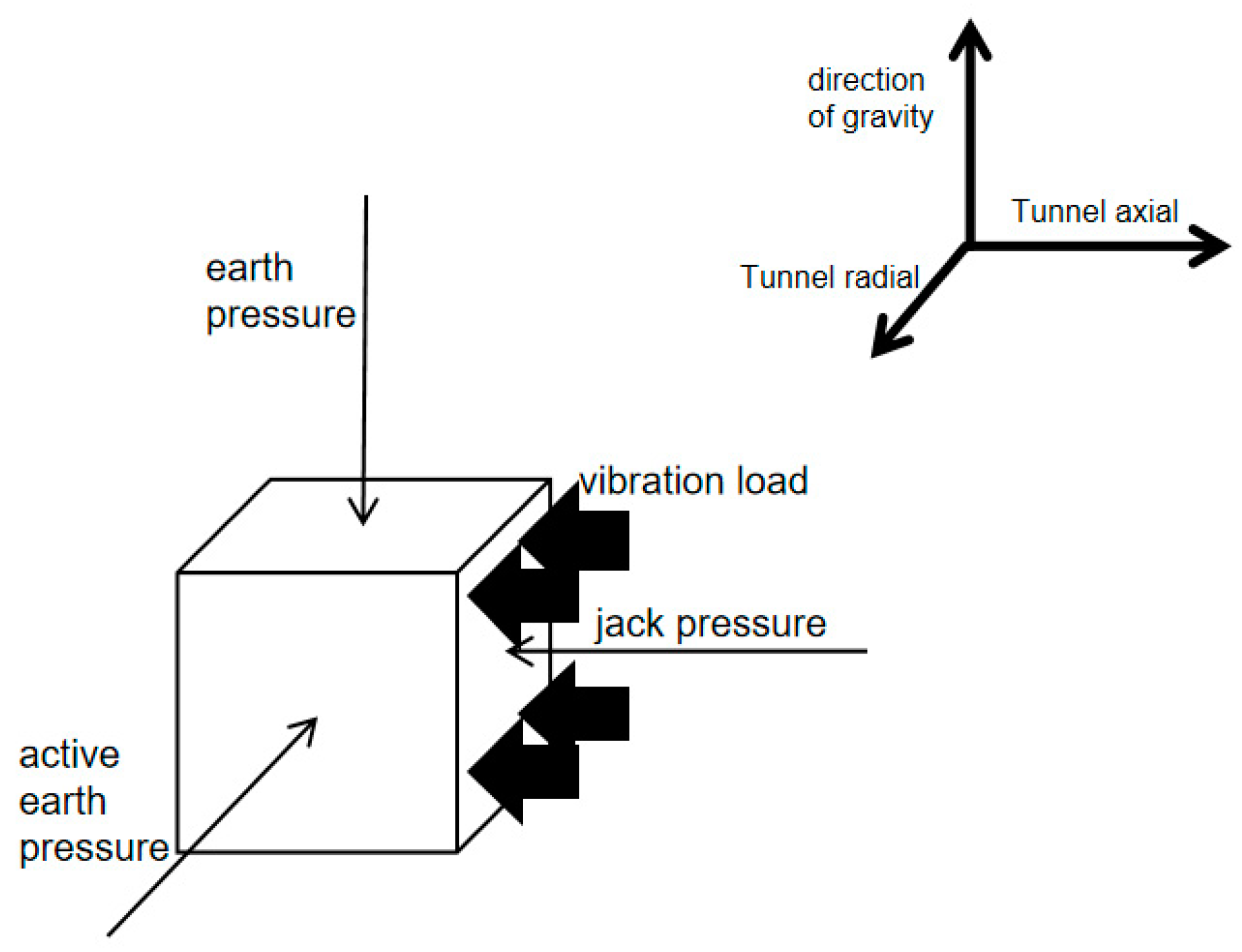
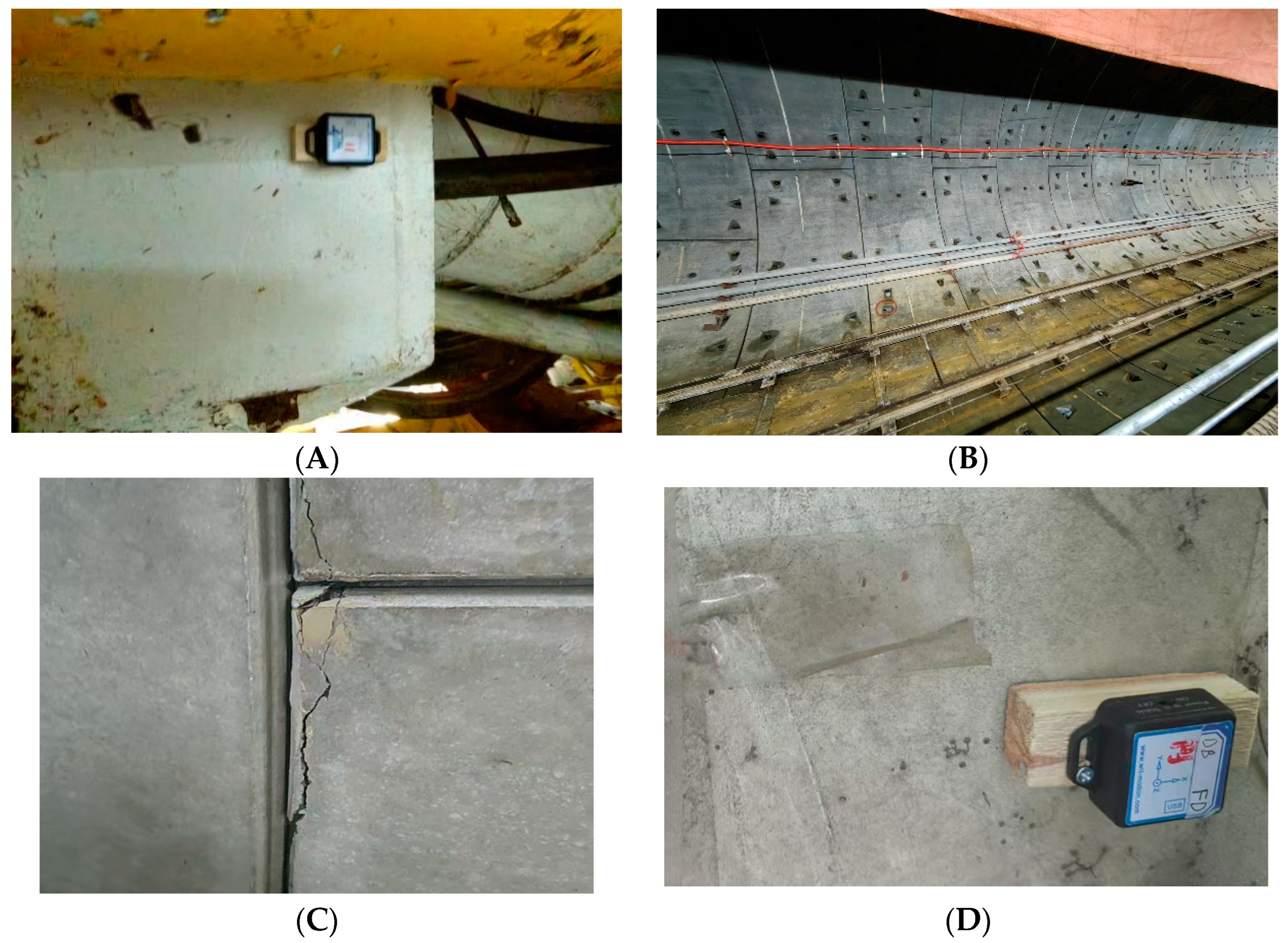

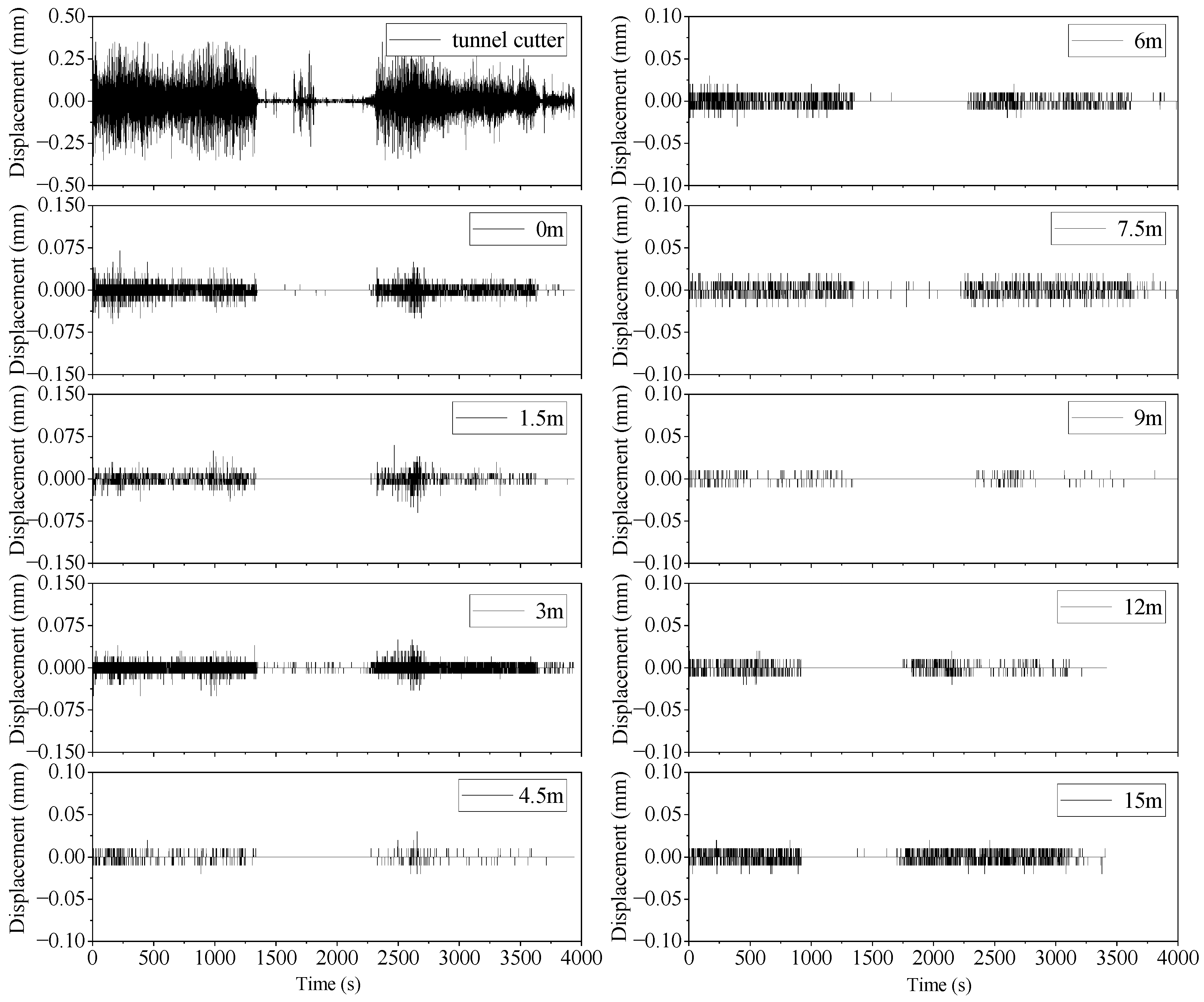
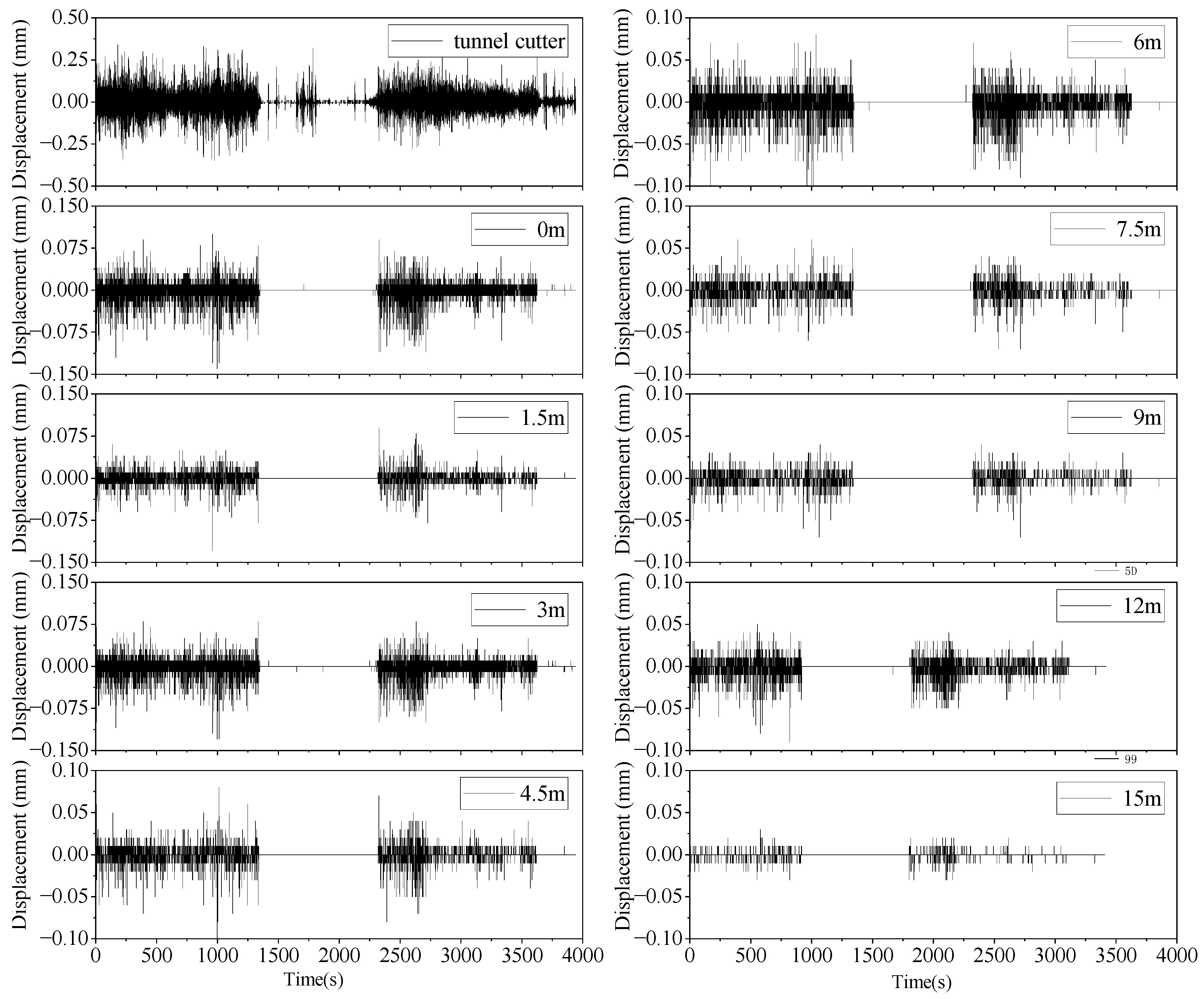
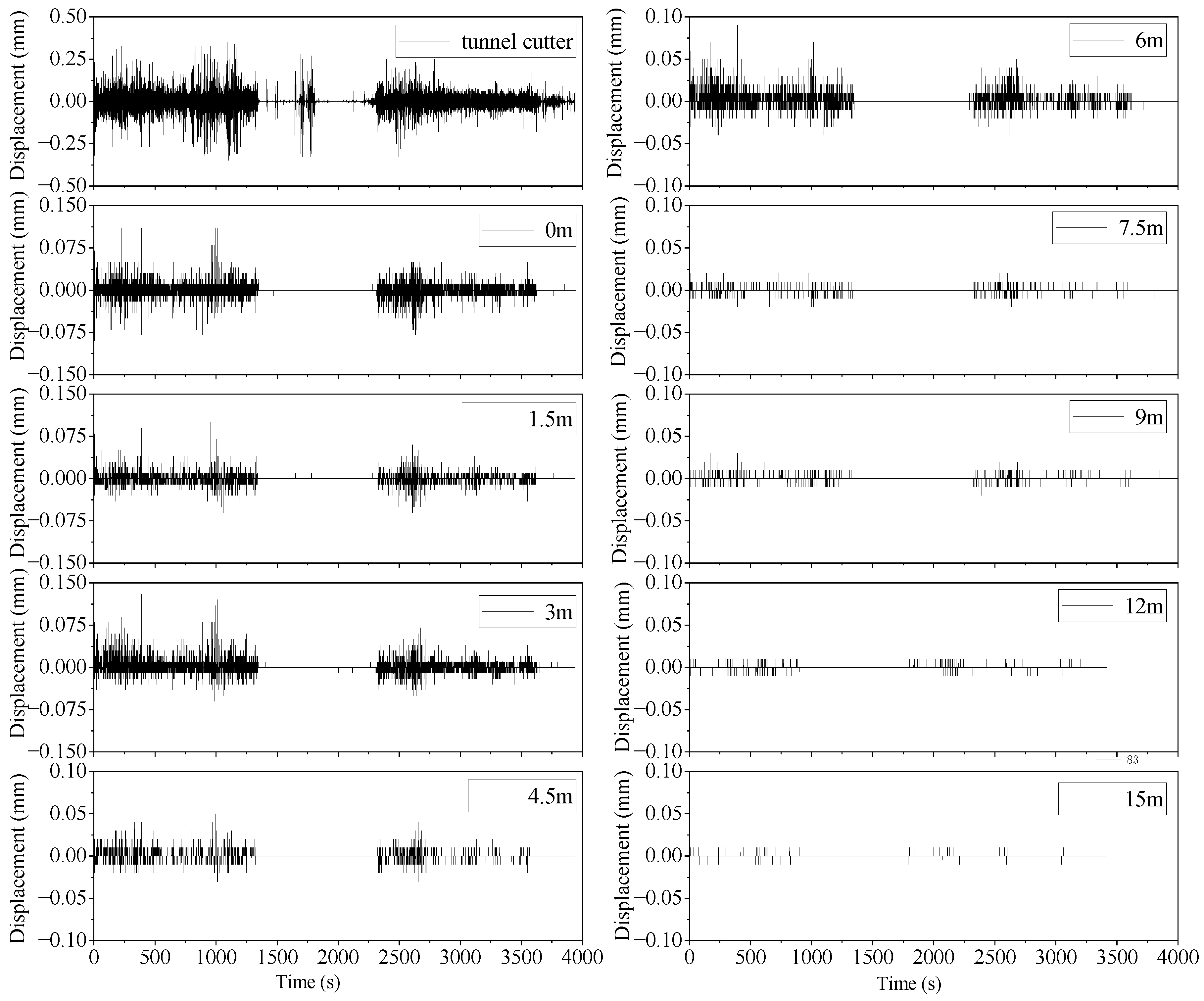


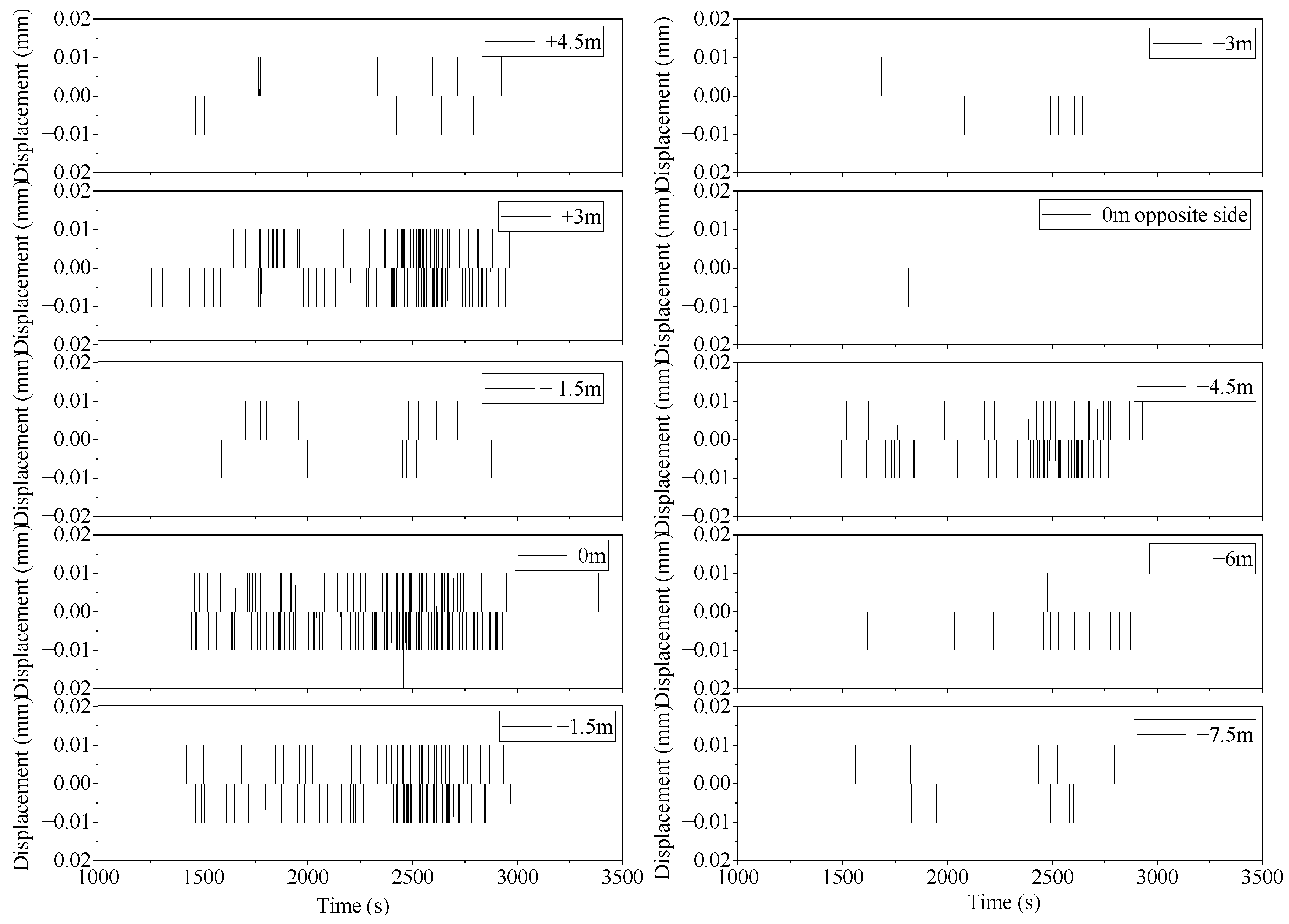
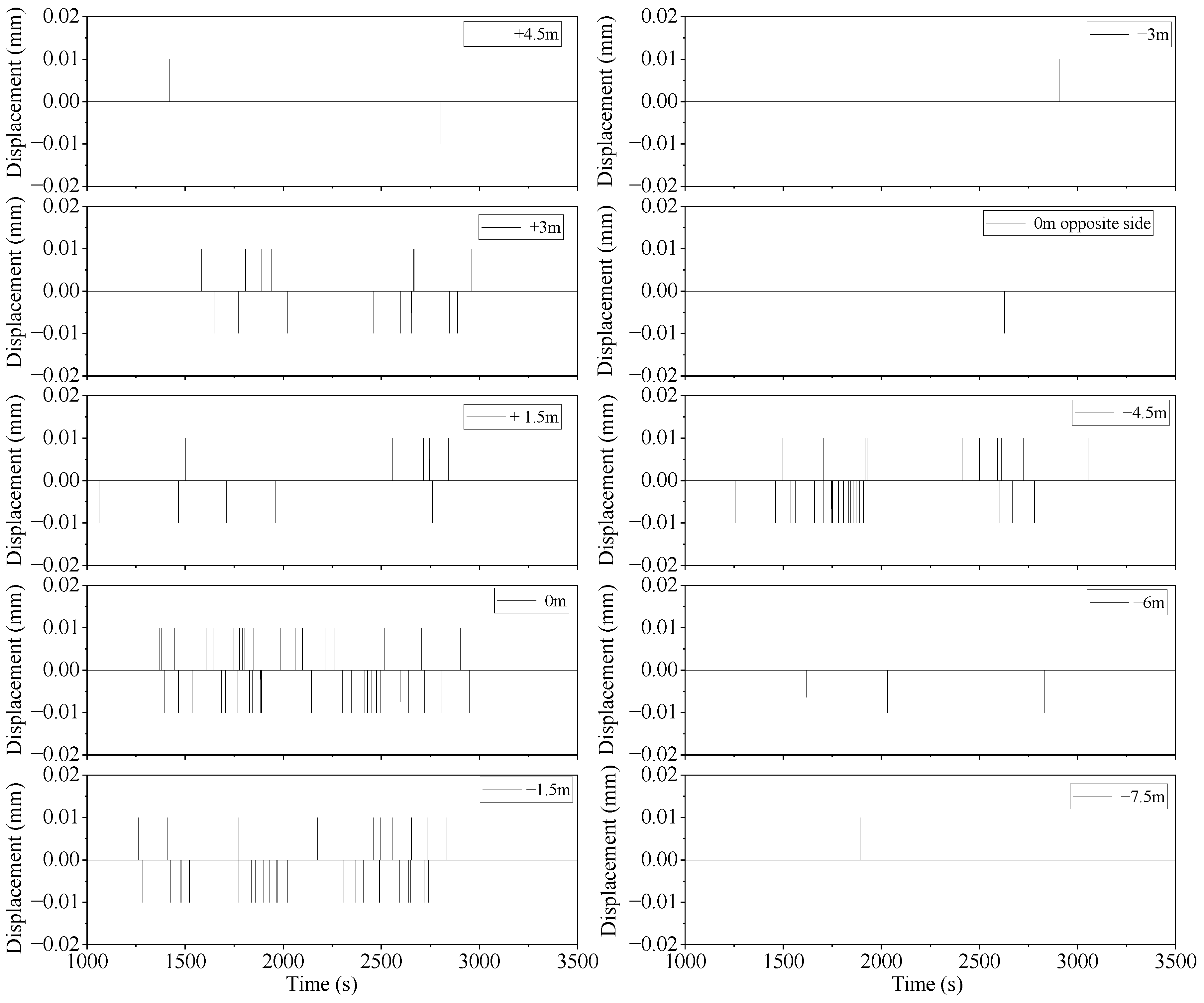
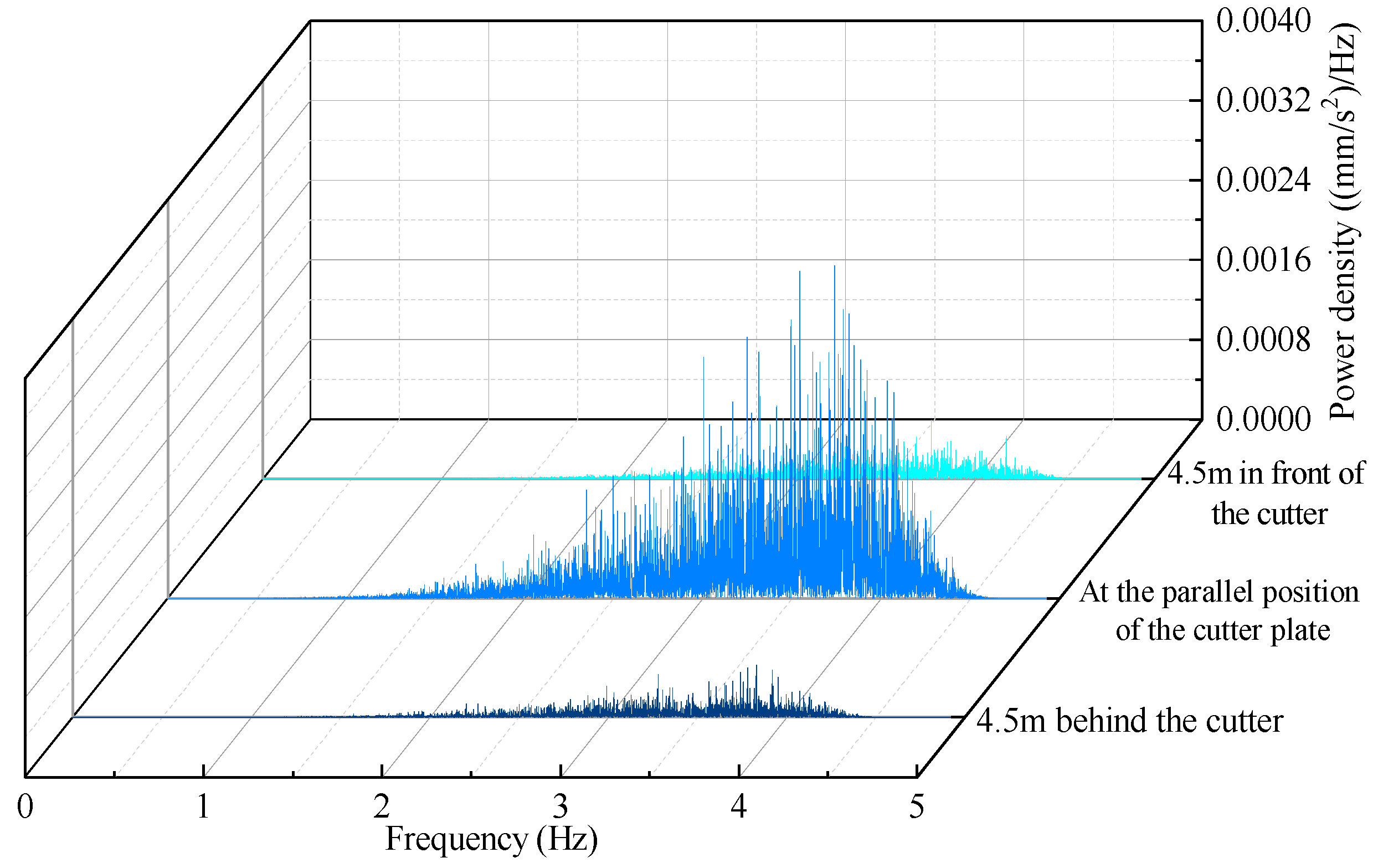

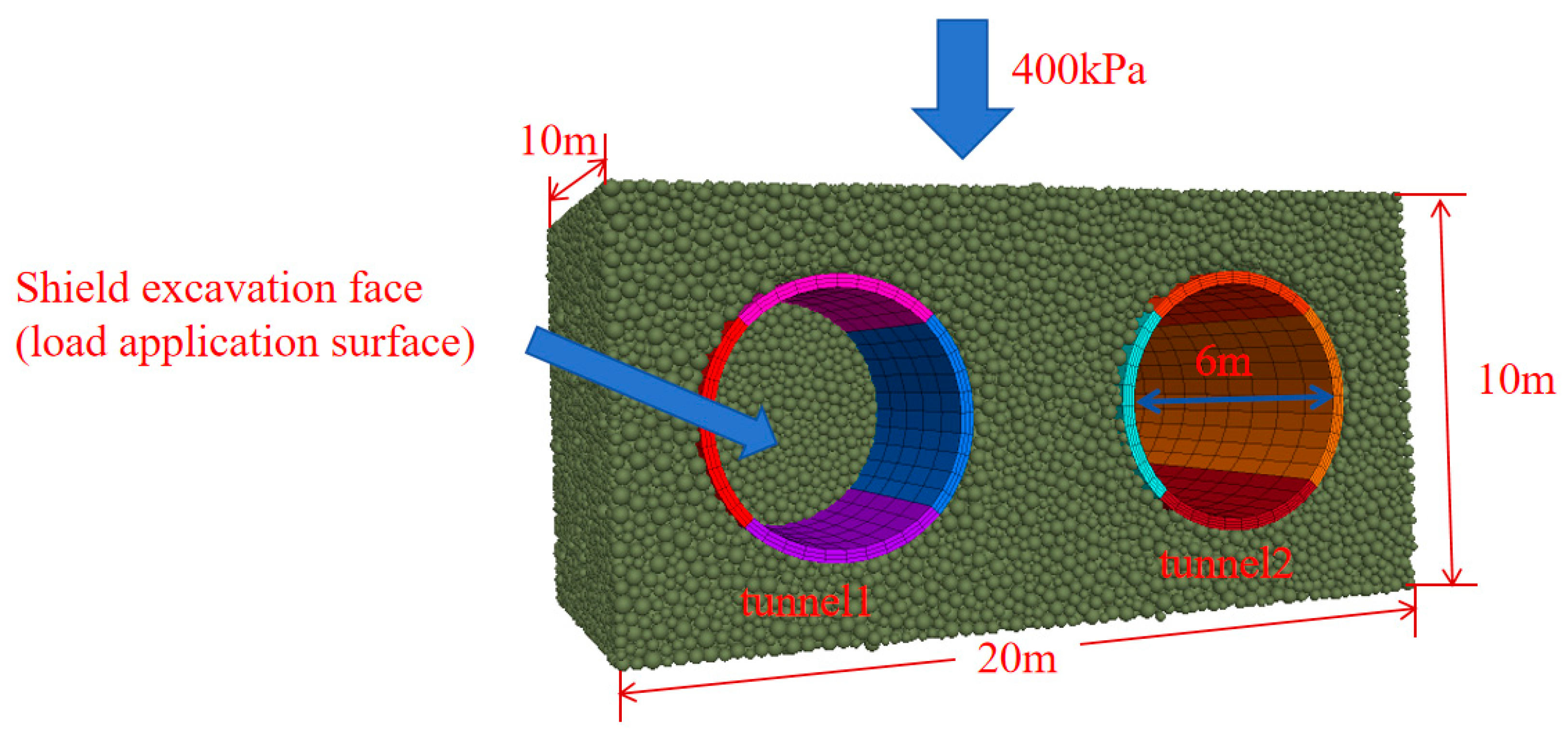

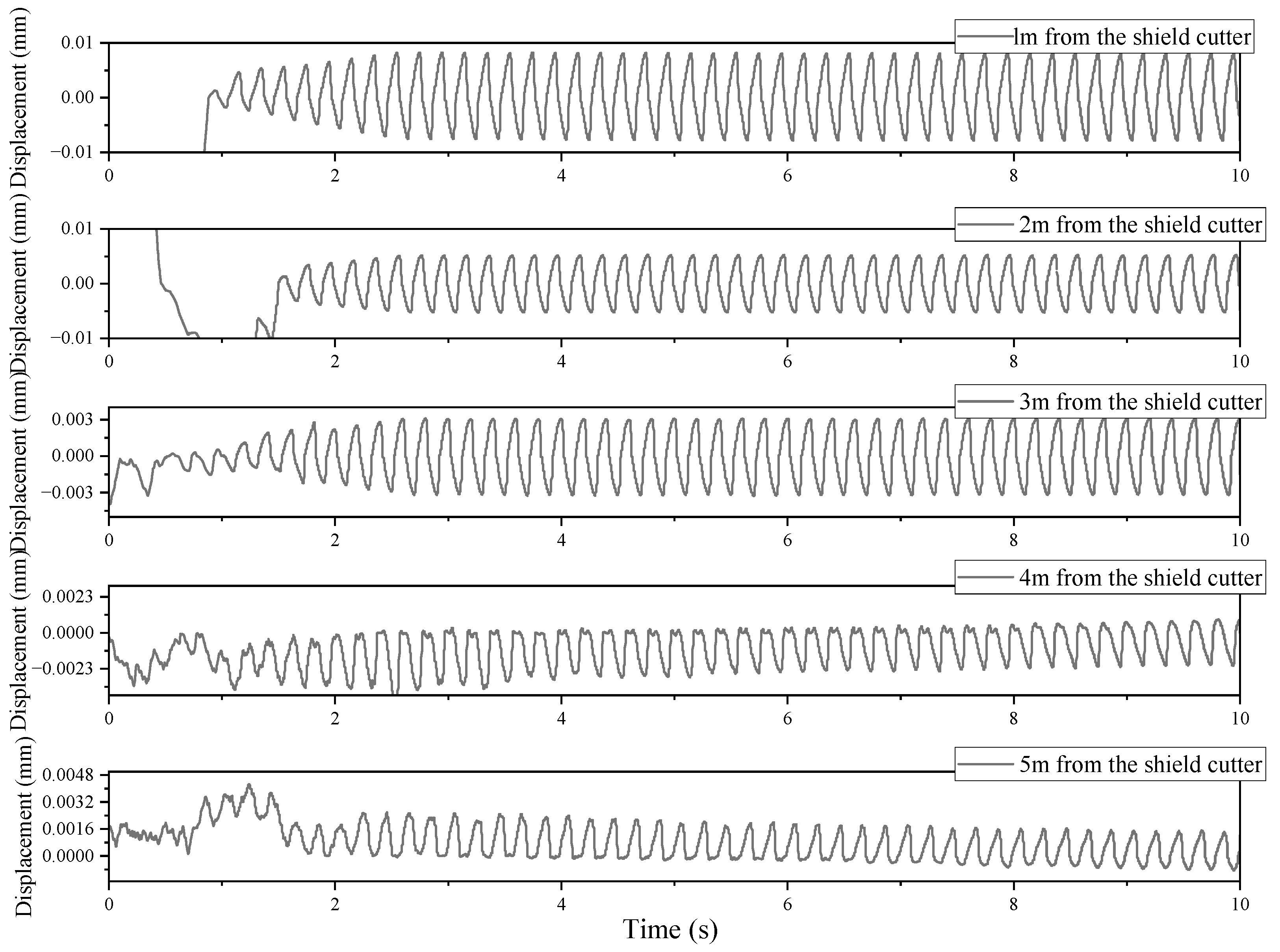
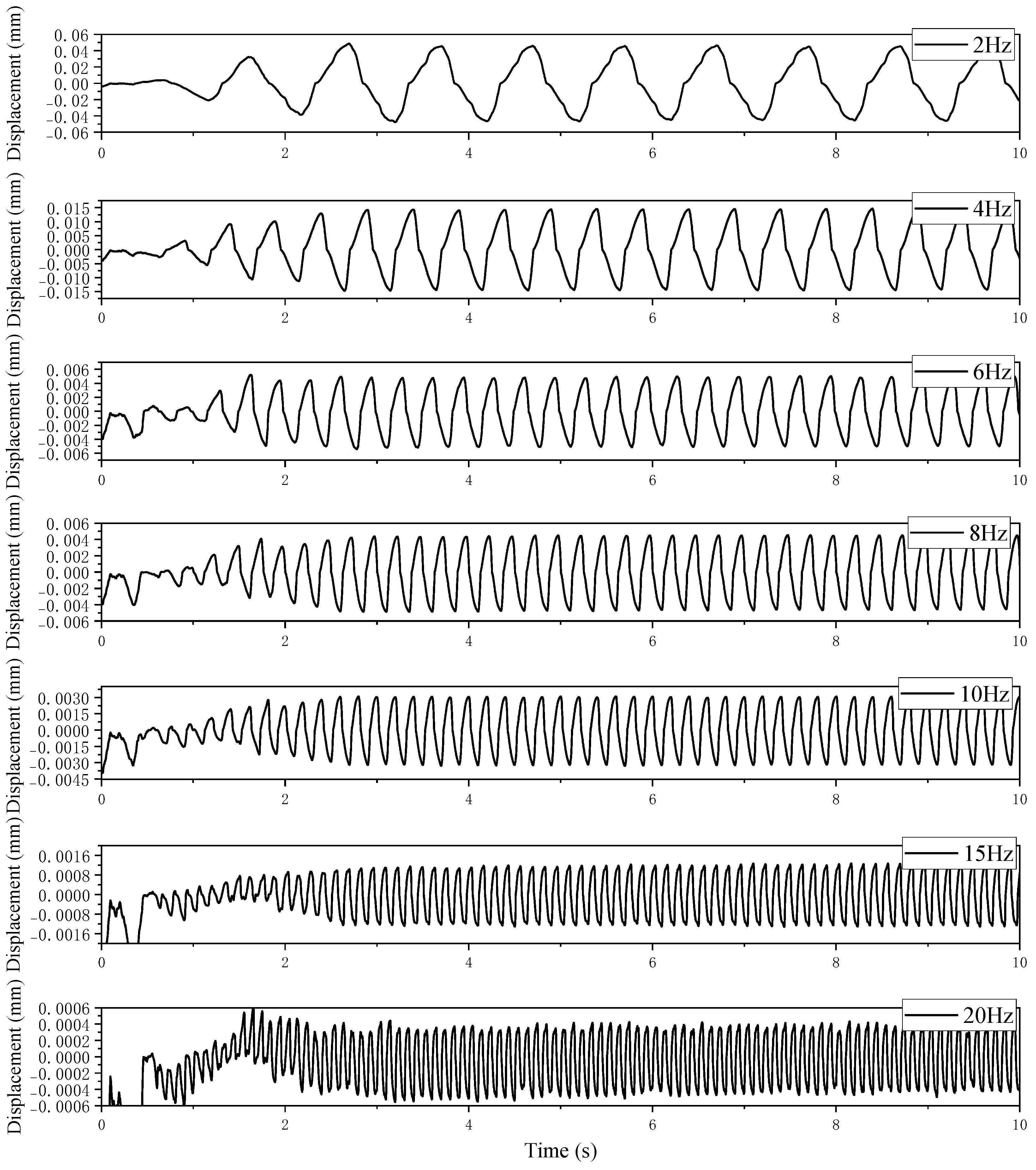
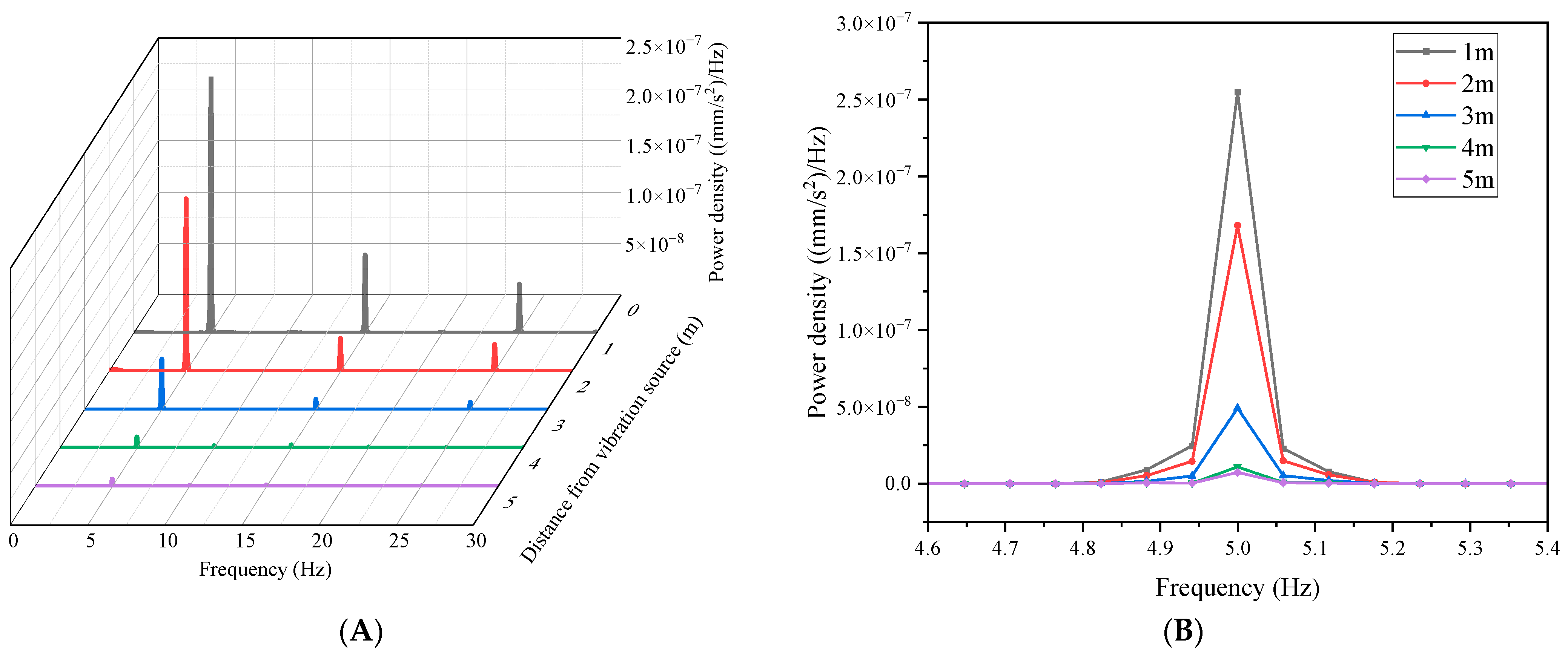

| Abbreviation | Symbol | Explanation Explained | Assignment |
|---|---|---|---|
| kn | kn | Normal stiffness | 2 × 107 |
| ks | ks | Tangential stiffness | 8 × 106 |
| fric | μ | Coefficient of friction | 0.5 |
| rgap | gr | Contact clearance | 0.5 × 10−4 |
| emod | E | Effective modulus of soil | 4 × 107 |
| emod | E | Effective modulus of concrete | 3 × 1010 |
| kratio | K | The ratio of stiffness in the normal to tangential directions | 1.5 |
| lin_force | Fl | Linear force (contact surface coordinate system) | 0 |
| dp nratic | Normal critical damping ratio | 0.05 | |
| pb_ten | δ. | Tensile strength (stress) | 1 × 105 |
| pb coh | e | Cohesion (stress) | 1 × 107 |
| pb fa | φ | Friction angle (degrees) | 0.0 |
| pb emod | E | Bonding effective modulus | 1 × 105 |
| pb kratig | K | The ratio of the stiffness of the bonding normal to the tangential direction | 1.5 |
Disclaimer/Publisher’s Note: The statements, opinions and data contained in all publications are solely those of the individual author(s) and contributor(s) and not of MDPI and/or the editor(s). MDPI and/or the editor(s) disclaim responsibility for any injury to people or property resulting from any ideas, methods, instructions or products referred to in the content. |
© 2025 by the authors. Licensee MDPI, Basel, Switzerland. This article is an open access article distributed under the terms and conditions of the Creative Commons Attribution (CC BY) license (https://creativecommons.org/licenses/by/4.0/).
Share and Cite
Wang, Y.; Yu, S.; Wang, R.; Ding, B. The Vibration Response Characteristics of Neighboring Tunnels Induced by Shield Construction. Appl. Sci. 2025, 15, 1729. https://doi.org/10.3390/app15041729
Wang Y, Yu S, Wang R, Ding B. The Vibration Response Characteristics of Neighboring Tunnels Induced by Shield Construction. Applied Sciences. 2025; 15(4):1729. https://doi.org/10.3390/app15041729
Chicago/Turabian StyleWang, You, Siyuan Yu, Rui Wang, and Bosong Ding. 2025. "The Vibration Response Characteristics of Neighboring Tunnels Induced by Shield Construction" Applied Sciences 15, no. 4: 1729. https://doi.org/10.3390/app15041729
APA StyleWang, Y., Yu, S., Wang, R., & Ding, B. (2025). The Vibration Response Characteristics of Neighboring Tunnels Induced by Shield Construction. Applied Sciences, 15(4), 1729. https://doi.org/10.3390/app15041729






